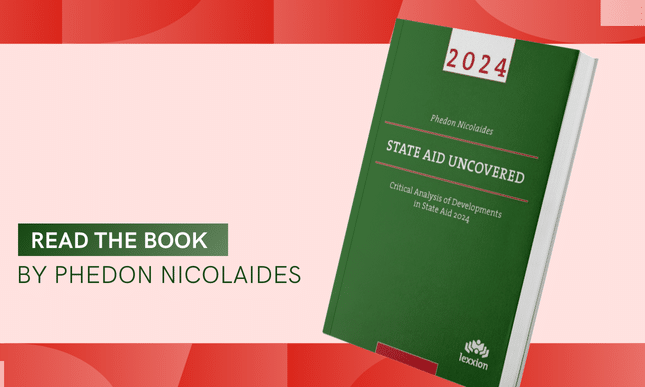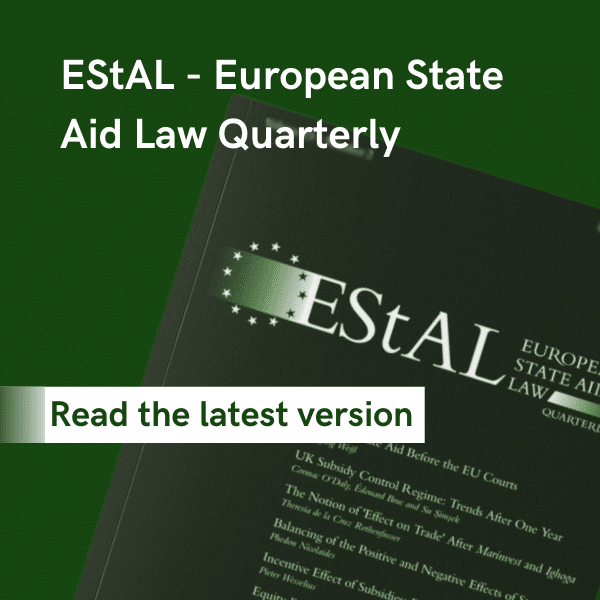Introduction The prohibition of State aid in Article 107(1) TFEU applies both to direct and indirect beneficiaries. The direct beneficiary is the formal recipient of the aid. However, the formal recipient may only act as an intermediary through which aid flows to third parties or may in fact be required by the aid measure to pass on some or most […]
State Aid Law
Blog
State Aid Uncovered Blog
In Lexxion’s State Aid Uncovered blog, Prof. Phedon Nicolaides publishes weekly critical analyses of recent State aid judgments and decisions. Each post presents the key points of a court judgment or EU Commission decision, places it in the context of similar case law or practice, assesses the underlying reasoning and highlights any inconsistencies or contradictions.
Guest contributions from other State aid experts will also be published on the blog at irregular intervals to complement the content of the blog posts.
- direct advantage ×
20. October 2020 |
State Aid Uncovered
by Phedon Nicolaides
Fiscal benefits to employees do not constitute State aid as long as they do not confer a direct or indirect advantage to their employers. Update on Temporary Framework: Number of approved and published Covid-19 measures, as of 16 October 2020: 302* Legal basis: Article 107(2)(b): 32; Article 107(3)(b): 255; Article 107(3)(c): 23 Average number of measures per Member State: 11 […]
16. June 2020 |
State Aid Uncovered
by Phedon Nicolaides
Public funding that flows through intermediaries to third parties also counts as a state resource if the intermediaries carry out instructions by the funding authority. Temporary Framework: Number of approved covid-19 measures, as of 12 June 2020: 154* Legal basis: Article 107(2)(b): 14; Article 107(3)(b): 130; Article 107(3)(c): 14 Three recapitalisation measures have been approved [Finland, Lithuania & Poland]. The […]
- direct advantage ×
6. February 2024 |
State Aid Uncovered
by Phedon Nicolaides
Introduction The prohibition of State aid in Article 107(1) TFEU applies both to direct and indirect beneficiaries. The direct beneficiary is the formal recipient of the aid. However, the formal recipient may only act as an intermediary through which aid flows to third parties or may in fact be required by the aid measure to pass on some or most […]
20. October 2020 |
State Aid Uncovered
by Phedon Nicolaides
Fiscal benefits to employees do not constitute State aid as long as they do not confer a direct or indirect advantage to their employers. Update on Temporary Framework: Number of approved and published Covid-19 measures, as of 16 October 2020: 302* Legal basis: Article 107(2)(b): 32; Article 107(3)(b): 255; Article 107(3)(c): 23 Average number of measures per Member State: 11 […]
16. June 2020 |
State Aid Uncovered
by Phedon Nicolaides
Public funding that flows through intermediaries to third parties also counts as a state resource if the intermediaries carry out instructions by the funding authority. Temporary Framework: Number of approved covid-19 measures, as of 12 June 2020: 154* Legal basis: Article 107(2)(b): 14; Article 107(3)(b): 130; Article 107(3)(c): 14 Three recapitalisation measures have been approved [Finland, Lithuania & Poland]. The […]
- direct advantage ×
6. February 2024 |
State Aid Uncovered
by Phedon Nicolaides
Introduction The prohibition of State aid in Article 107(1) TFEU applies both to direct and indirect beneficiaries. The direct beneficiary is the formal recipient of the aid. However, the formal recipient may only act as an intermediary through which aid flows to third parties or may in fact be required by the aid measure to pass on some or most […]
20. October 2020 |
State Aid Uncovered
by Phedon Nicolaides
Fiscal benefits to employees do not constitute State aid as long as they do not confer a direct or indirect advantage to their employers. Update on Temporary Framework: Number of approved and published Covid-19 measures, as of 16 October 2020: 302* Legal basis: Article 107(2)(b): 32; Article 107(3)(b): 255; Article 107(3)(c): 23 Average number of measures per Member State: 11 […]
16. June 2020 |
State Aid Uncovered
by Phedon Nicolaides
Public funding that flows through intermediaries to third parties also counts as a state resource if the intermediaries carry out instructions by the funding authority. Temporary Framework: Number of approved covid-19 measures, as of 12 June 2020: 154* Legal basis: Article 107(2)(b): 14; Article 107(3)(b): 130; Article 107(3)(c): 14 Three recapitalisation measures have been approved [Finland, Lithuania & Poland]. The […]






